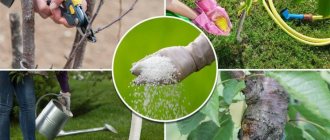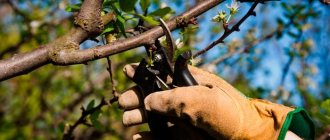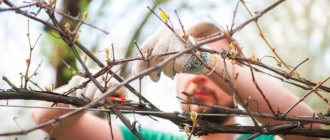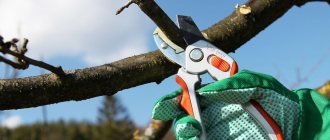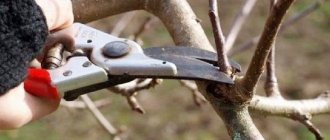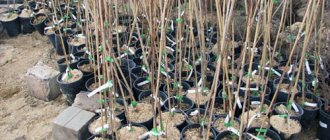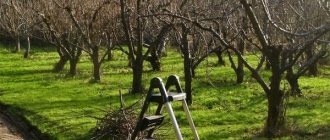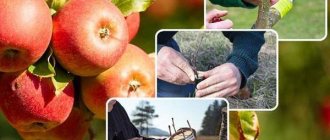With the onset of spring, the “hot season” begins for gardeners.
It is necessary to put things in order in the garden: remove garbage, rotten leaves, whitewash and spray trees and shrubs. Mandatory spring agrotechnical measures include pruning fruit trees. Today we will figure out why it is needed, what rules exist for its implementation, and what nuances a beginner needs to know about. Dear readers! For you, we have created communities on social networks in which useful articles and interesting ideas are published several times a day! Subscribe and receive useful content in a convenient format!
When to prune fruit trees in spring
Choosing the right day to carry out the work is very important. If you cut branches when it is still frosty and the snow has not melted, then there is a chance that low temperatures will destroy the plant. If you delay the procedure and carry out pruning, for example, in May, when flowering begins, the tree may stop blooming altogether or even dry out.
The optimal time for sawing garden trees is from the second ten days of March to the end of the first ten days of April. Work should be carried out in light frost (0 - 3 degrees).
IMPORTANT! The temperature should under no circumstances drop below -5!
You can cut at a positive temperature only if sap flow has not begun, that is, at a temperature of about 5 degrees.
What tools will you need?
The list of necessary equipment may vary depending on the age category of the trees in your garden. However, the tools must meet one requirement:
- they must be as sharp as possible to obtain even and smooth cuts;
- everything should be safe and easy to use;
- the ends of the pruning shears and loppers should be as narrow as possible;
- you need to store tools in a dry place and put them in order after each job;
- the handle should be non-slippery and bright;
- Light weight tools must withstand heavy loads.
Prepare the following:
- Garden secateurs. Pruning with pruning shears is carried out on branches with a diameter of up to 2 cm, since thicker cuts may result in burrs and burrs.
- Garden hacksaw. This tool is used for cutting large diameter branches. A hacksaw should be chosen with a blade size that will be convenient to use. In this case, the inclination of the teeth should be 5 mm, and the handle should be slotted, which will prevent the tool from slipping in the hand.
- Secateurs with a long handle. This version of the tool allows you to trim thicker branches with a diameter of up to 4 cm and trim higher branches.
- Gasoline or electric saw. It is used only in extreme cases for cutting out old, withered trees, dry and thick branches.
You may need a ladder or stepladder if the branches to be removed are taller than you are.
When should you not prune trees?
It doesn't happen year after year. Sometimes winter is delayed, sometimes spring comes very early. Therefore, when choosing the timing of filing branches, you must first of all focus on weather conditions.
Do not prune in frosty conditions. As mentioned above, this can destroy the plant. But, in addition, the branches will be fragile and instead of neat cuts you will get chips. That is, there will be no decorative pruning.
There is also no need to file if the weather warms up very early and very quickly. It is better to postpone the procedure until the fall than to cut down shoots in which sap flow processes have already begun.
Pruning garden trees in 2022 according to the lunar calendar
The life cycle of plants is influenced by lunar phases. This fact has been proven not only by the centuries-old experience of our ancestors, but also by the research of modern scientists.
When sawing off shoots, it is necessary for the plant to experience the least amount of stress. Pruning carried out during the waning moon is considered less traumatic for trees.
During this phase, plant juices rush down to the roots and, accordingly, the branches react weakly to external influences and heal faster after a traumatic procedure.
According to the lunar calendar for 2022, spring pruning is favorable for trees on March 5 or 6. These days are considered the most successful for fruit-bearing plants in the garden.
What are the features of the procedure in spring?
First of all, let's talk about some of the nuances of the procedure.
- Prepare your instrument. Secateurs, saws, loppers - everything must be sharpened and disinfected. This is necessary so that the cuts are neat and infection does not get inside.
- Get the right tool. You will have to remove both large and small knots. Everyone needs the right tool. Firstly, it will simply be more convenient for you to work. Secondly, you do not injure the shoots.
- Don't be too overzealous when working with young trees. You just need to shape the crown, remove diseased branches, and also remove growth so that there is no competition.
- When removing a thick branch, first saw it from the bottom, and only then saw it from the top. This way, your branch will not break off and pull the bark along with it.
- Be careful with your kidneys! When pruning to the bud, hold the cutting tool at an angle of 45 degrees and point it towards the top of the branch. The upper corner of the cut should be a couple of mm above the bud.
Preparation of tools and materials
Pruning of young and old trees in the spring should be done with sharp pruning shears, a hacksaw and garden shears. You need to carefully prepare your work equipment; it is advisable to disinfect it in salt water.
The solution is prepared at the rate of 1 tablespoon of table salt per 1 liter of water. Soak the equipment for several hours. If the instruments are not properly treated, the cut site may become infected with fungi.
All tools must meet the following requirements:
- To make the cut easy and not injure the branches, the blade must be well sharpened.
- Equipment with tapered ends will allow you to reach hard-to-reach places.
- Secateurs, hacksaws, hedge trimmers and loppers should be lightweight.
- Handles on tools must be made of non-slip materials.
Advice!
When buying gardening tools, choose tools with brightly colored handles.
Such tools are easy to find in the grass.
Types of spring pruning and when to use them
In total, there are 4 types of spring pruning:
- Formative.
- Rejuvenating.
- To reduce growth.
- Sanitary.
Each filing is carried out at its own time. All types are aimed at increasing the yield and its quality, increasing the amount of sunlight inside the crown (this will also affect the quality of the fruit). Also, removing excess twigs helps the tree rejuvenate, redistribute strength and strengthen the immune system.
Formative filing is necessary for decorative purposes and the formation of the correct crown. A properly designed crown evenly distributes nutrients throughout the tree and prevents shoots from getting sick. This pruning is carried out in the first 4 years of the tree’s life.
The rejuvenating procedure is carried out on old specimens. It is needed to remove old branches and stimulate the formation of new twigs. This procedure can be carried out once every four years after 3 years of growing the crop in the garden.
Pruning is also done in the spring to reduce growth. It is needed to redirect the tree’s forces from the formation of new shoots to the formation of tasty fruits. Its duration is the first 4 years of the tree’s life.
Sanitary pruning is carried out regularly. It can even be done in the middle of the season. Its purpose is clear from the name. We remove diseased and dry shoots, as well as those twigs that grow inside the crown and thicken it.
Ideal crown
All dry branches must be cut to a healthy place. If there is an empty space in the crown, that is, a space not filled with branches, then when pruning, the nearest branch is cut above the eye directed into this free space of the crown.
Balance is maintained between the branches of the crown so that the crown always remains symmetrical. All branches growing inside the crown are cut to the base.
A well-formed crown must have at least four main branches, of which one shoot is directed upward and serves as a continuation of the trunk. The remaining three make up the side branches. With five branches the crown is even better, but this is only if the tree has a strong trunk.
Apple and plum trees grow to the sides, so their crown should have a spherical shape.
The pear grows upward, forming a pyramidal crown.
Cleaning the crowns of fruit trees is done first annually, and when the tree reaches 25 years of age - once every two years. The benefits of clearing the crown of barren and dry twigs are obvious: the inside of the crown will become lighter and it will be well ventilated.
Technology for pruning branches in spring
Tree sawing is an ancient agrotechnical technique. There are several methods for pruning branches:
- Bud pruning. This method is needed to direct the growth of branches in the desired direction. We find a one-year-old branch and look for a bud on it that looks in the direction we need. We position the pruning shears so that it is slightly higher than the bud. Angle – 45%. There is no need to tilt it any further so that the sap flow is not disrupted.
- Filing into a ring. This method is needed to remove excess branches, because the tree wastes nutrients on them. First, select a tool based on the size of the shoot. We prune so that there is no stump left, but not too deep so that there is no wound. That is, along a circular flow.
- Pruning for lateral branching. This method is needed to redistribute tree resources from one branch to another. Thus, the growth of new fruiting shoots is stimulated.
ON A NOTE. These methods help lighten the load on the plant and increase the amount of light penetrating into the tree.
Schemes of crown formation in spring
There are many schemes for forming the crown of fruit trees in the spring. Below we will look at just a few of the most interesting and effective ones.
Why is it necessary to form a crown? To grow strong skeletal branches that will support the weight of the fruit. The second reason is to limit the growth of the tree and stimulate fruit formation.
So, 4 schemes for crown formation in spring.
- Tiered (tiered rarefaction). Common method. Its essence is to preserve the natural appearance of the tree. Externally, the crown with this filing resembles a pyramid directed upward.
- Vertical (vertical palmette). This crown formation pattern represents the development of lateral, almost horizontal skeletal branches.
- Fusiform. This scheme is suitable for stone fruits (apricot, plum). The crown is formed in the form of an oval.
- Cup-shaped. The essence of this scheme is to form a bowl from the lateral skeletal branches. In this case, the central trunk is shortened. This scheme is suitable for the most capricious plants (for example, peach).
Calendar terms of the procedure for different regions
It is necessary not only to know how to trim a tree correctly, but also to choose the optimal time for such work. Inappropriate timing is one of the reasons for long-term planting stress, illness, and in some cases, death.
Branches are removed in spring, summer and autumn. In the southern regions, in warm weather it is allowed even in winter. But still, the most common is spring pruning of fruit trees, before the sap begins to flow. One of the conditions is above-zero temperature.
Why at this time:
- no loss of juice;
- during a favorable period, plants experience stress more calmly;
- In the spring there are no leaves yet, so a good view and overview of the skeletal branches is ensured.
Spring warmth arrives in regions at different times, so the specific weather conditions of a particular area are taken into account.
They start working with pome-bearing species (apple trees, pears, quince) earlier, and with stone fruit species (apricots, cherry plums, cherries, plums, peaches, cherries) – later. At the same time, if necessary, cut off the branches even at the end of May, it all depends on the situation.
In the south they begin removal in February - early March, in the Moscow region - in April, in the regions of the North-West, Urals, Siberia - even in May. In the northern regions, there is a high risk of return frosts, so you should not rush too much with pruning.
Experienced gardeners also practice summer pruning, but this only concerns the shaping of young trees. For them, the procedure in the summer is not only possible, but also effective. Tweezing (pinching), breaking out shoots, and removing eyes (buds) are used.
Another reason for the summer operation is the freezing of the tree in winter. The fact is that in early spring it is difficult to establish the limits of branch deformation, but when the buds open, this is immediately visible.
It happens that for various reasons the procedure has to be carried out in the fall. In this case, it is especially important not to miss the deadline, otherwise the crops will not have time to straighten out after removing the branches and will go into winter weakened. And you can’t rush: while the leaf is firmly held on the branches, it is difficult to carefully examine the crown, identify deformations and diseased shoots.
The optimal time is after the tree has completely defoliated, before the dormant period approaches. In this case, it is necessary to take into account forecasts and approximate timing of the onset of cold weather. The work is completed three weeks before the arrival of sub-zero temperatures.
On a note! Pear, apple, and plum trees can be pruned in the fall. For crops with poor winter hardiness (cherry, apricot, peach, sweet cherry), work is planned for the spring.
Features of pruning young trees in spring
If you have young apple trees, pears, apricots and other fruit trees, then you need to be very careful when pruning them. There is no need to file too much.
COUNTRY SECRET. The first filing is carried out in the year of planting and consists of shortening the trunk.
In the first years, it is very important to stimulate the formation of new side shoots, which will bring the main harvest to the summer resident. It is very important to remember that the central conductor should always be slightly higher than the side shoots.
It is also very important to start forming a crown from a young age. To do this, you need to identify the necessary branches, remove competitors and carry out filing on the bud in order to stimulate the growth of branches in the direction you need.
Terms in gardening
The literature intended for beginning gardeners and people with experience is literally replete with terms. The table will help you understand them. When reading the article, look into it, or maybe also into the “gardener’s dictionary”.
| Term | What does it mean |
| Fruit tree trunk | The section of the trunk between the root collar and the first branch |
| Center conductor | The section of the trunk from the first lower branch to the top |
| The escape | A twig growing from last year's bud |
| Tops | Shoots growing vertically and reaching a length of up to 2 meters |
| Escape Rival | A strong branch growing from a lateral bud located slightly above last year's growth |
| Pincing | Manipulation aimed at stopping shoot growth. To do this, pinch off the top with 2-3 leaves. |
| Fat shoots | Strong tops at the bases of branches that appear when the tree ages or is improperly pruned. |
How to prune mature trees in spring
For pruning to be meaningful, it must be done regularly. This also applies to adult apple trees, pears, plums, apricots, etc.
Very old trees, which are already more than ten years old, require, first of all, regulatory and sanitary pruning. The tree can also be rejuvenated.
Otherwise, a beginner should be guided by the following principles:
- Dry and diseased knots, as well as those that grow inward, must be removed.
- Cut out bare branches. They will not produce a harvest.
- Remove skeletal shoots only as a last resort. For example, they interfere with the growth and development of fruitful young shoots.
- We shorten those shoots that are longer than 3 m.
- Cut out the tops.
How to prune an apple tree in spring
The apple tree is sawn down to make its crown more decorative. For the first time, the procedure is carried out in the first days after planting a young seedling. Trimming takes place in 2 steps:
Step 1. Leave the central trunk up to 0.9 m high.
Step 2. Find side branches directed in different directions and cut them to 25-30% of their length. In this case, the central trunk should be 0.2 m higher than the skeletal branches of the upper tier. These same upper shoots should be shorter than the lower ones.
When the apple tree grows a little, we will need to periodically remove dry, diseased branches, as well as those shoots that interfere with the development of the tree, thicken the crown and are directed inside the tree.
ON A NOTE. The central trunk (conductor) should ALWAYS be higher than the other shoots.
If you are rejuvenating an apple tree, then you must carry out the procedure very, very carefully. It is better to cut off a few large branches from an old tree rather than many young branches. This will make it easier for the apple tree to withstand pruning.
To prevent the apple tree from growing very tall, you need to periodically trim the central conductor by 30% of its length.
How to prune a pear tree in spring
The pear tree is a close relative of the apple tree, and its filing is very similar.
You also need to immediately shorten the seedling and saw off the skeletal branches in a similar way.
The pear needs to be sawed every year. Be sure to ensure that large vertical branches (so-called tops) do not form. They do not produce fruits, but only parasitize and suck nutrients that would be useful for the formation of fruits.
Also make sure that the crown is not too thick, as this harms the fruit formation and taste of the fruit. To do this, file the pear so that the weaker branches are higher than the stronger ones.
IMPORTANT! The pear cannot be cut into a ring, as this is detrimental to the health and appearance of the plant. The pear is sawed off for shoots.
How to prune an apricot in spring
Apricot grows well even in Central Russia. But this tree is very capricious and requires a competent approach to pruning.
If you just planted an apricot in your garden, then cut it to half a meter in height and remove all side shoots. The method is “on the ring”.
For the 2nd year of cultivation, we leave 2-3 skeletal branches and cut off the rest. The remaining shoots should be no more than 25 cm in length. Don't forget to shorten the central conductor. We don't need it to stretch out. It should rise 15 cm above the rest of the shoots.
The third year of an apricot's life in your garden is the most important. We leave only 5 powerful branches below and cut them to 0.5 - 0.6 m in length. We check the central shoot. If it is too long, cut it off.
In subsequent years, apricot requires only sanitary pruning. We make sure that the tree does not grow too tall (no higher than 2 - 2.5 m). We also remove all interfering and competing branches. We carry out pruning “to the ring”.
To form the crown of a fruit tree, follow the instructions:
Cut the central shoot (conductor) at a height of 80 cm from its base. The distance is approximate, the main thing is that there are 8-10 buds left on the conductor, from which new shoots of continuation and lateral branches are formed. This is how the first tier is formed.
The next year, inspect the seedling, remove frost-damaged branches, then select the 2 or 3 strongest. Cut off the rest. You have formed the second tier.
The third tier is formed according to the same principle for the 4th year.
As soon as the fruit tree reaches a height of 4 meters (if the variety is low-growing - maximum height), cut the conductor above the top strong branch: you will stop growth. The crown of the young tree is formed.
Remember that with the described method you cannot oppress the tree, eradicating the inherent characteristics of the variety.
Prune plums in spring
NOTE! It is very important to prune the plum immediately after planting (to 0.7-0.8 m). This is necessary so that the fruit branches do not lay high, and in the future it is possible to form the crown of the plant.
In the following years, we gradually remove all competing shoots and shorten the skeletal branches. When the plum grows, we strictly prune the main trunk so that it does not grow higher than 2.5 m. Otherwise, the tree will be ugly, and the plums will grow on the upper tiers.
Pruning cherry trees in spring
If you think apricots are the hardest, then you've never encountered cherries. This is a tree that, in just a couple of seasons, can become so overgrown that not a single ray of sunlight penetrates the crown.
Cherry trees need to be thinned out by cutting off dry and bare branches, as well as those that interfere with the rest. You need to file on the ring and the outer bud, since cherries love to grow inside the crown.
The main spring pruning of cherries occurs in the 2-3rd year of its growth. It is necessary to leave 5 skeletal shoots, and cut off the remaining competing branches without leaving knots, that is, to a ring. Thus, we form the crown of the tree. In the future, every spring you need to carry out sanitary pruning and make sure that the shoots do not grow inside the crown.
Reviews from gardeners
– Any pruning is a way to achieve the desired shape of the tree crown and the desired yield. In my opinion, apple and pear trees should not be subjected to such a procedure. Unless you remove the dead branches, the diseased ones.
Yuri, Krasnodar
- Of course, pruning is needed! How can we live without her? How to remove the same tops without trimming? What about bent branches? Therefore, I am categorically against those gardeners who believe that the tree should be allowed to develop naturally. They definitely have a small harvest.
Olga, Kachkanar
– Our whole family loves and cherishes raspberries. Every spring I prune, leaving the strongest and healthiest. Old canes need to be removed; there are no berries on them anymore.
Vladimir, Suzdal
Natalia
Author
Ask a Question
To get a good harvest, the crop should be cared for all year round. In the spring, work begins in March, when it is necessary to bring trees and shrubs into working condition, that is, to prune them. It is important to take into account that a specific culture requires its own approach.
Pruning cherries in spring
The purpose of filing the cherry tree is to create a compact, neat crown and prevent the branches from stretching out.
According to tradition, in the first year it is necessary to shorten the trunk, in the second year we carry out filing on the outer bud. At the same time, we remove everything that can compete with the central shoot.
In subsequent years, we simply make sure that the skeletal shoots do not grow too long (this makes them bare).
Peach pruning in spring
The peach is sawed off so that its crown looks like a bowl.
The first filing is also carried out very early, in the year of planting. You need to cut off everything above 20 cm above the graft. Thus, fruiting shoots will be laid very low.
ON A NOTE. File away old branches without regret. Peach bears fruit on annual branches.
In the 2-3rd year of growth, all formed branches are sawed off to the level of 3 buds. Next, we prune so that there are 3 to 5 powerful shoots left on the tree. This is the optimal number of skeletal branches for a peach tree.
Peach trees must be pruned in the spring. Moreover, this needs to be done “on the fly.” This way you will avoid a situation where the fruits begin to grow on the upper rather than lower branches.
Just like with other fruit trees, do not forget to remove broken, infected, dry branches every year. This is necessary so that the tree does not waste its energy on them.
Advantages and disadvantages of pruning fruit trees in spring
Spring pruning has a number of positive aspects:
- Formation of a beautiful crown;
- Strengthening the trunk and skeletal branches;
- Productivity increases;
- Growth of fruiting shoots;
- The lifespan of the tree increases;
- The taste qualities of the fruits increase.
There are, however, a number of disadvantages. Among them:
- It is difficult for a beginner to determine the correct date for the procedure;
- The effectiveness of pruning cannot be assessed immediately;
- It is difficult for a beginner to file correctly right away. Mistakes are often made when pruning into buds and rings. Stumps are left behind, the wrong branches are cut, etc.
- There is a risk that a beginner will prune too many shoots at once. This will lead to late fruiting.
Tips for beginners
Our 10 tips for beginning gardeners.
- Follow the appropriate pruning pattern for each crop.
- First file the bottom of the knot, and then make the main cut to avoid chipping.
- Use only sharp and high-quality tools.
- Take your time. First, determine which branches need to be cut, mark them, and only then proceed with the procedure. Follow the rule “Measure twice, cut once.”
- Learn basic filing techniques.
- Don't leave stumps.
- Treat the cuts with garden varnish or another preparation with similar properties.
- Follow the work deadlines.
- Carry out filing every spring.
- Handle young trees with care.
Common mistakes when pruning
Starting to grow garden crops is always very difficult and mistakes in this matter cannot be avoided.
Pruning experience comes with age, but to avoid banal problems, you should listen to the advice of experienced gardeners:
- The pruning scheme for each tree and shrub is selected depending on their type, that is, on the characteristics of development and growth.
- Sawing must be done extremely carefully, as excessive damage has a negative impact on fruiting. To prevent infection and accelerate overgrowth, sections are treated with garden varnish.
- Pruning must be carried out annually, otherwise there is no point in it.
- Avoid heavy sawing and pruning with stumps, as this not only worsens the decorative appearance of the bush, but also prevents the formation of healthy fruits.
- There's no need to rush. First, with a marker or other device, mark those branches on the tree that need pruning and only then proceed directly to the procedure.
Before starting work, it wouldn’t hurt to watch videos that explain pruning rules with examples.
In many cases, information “live” is perceived much better compared to theoretical knowledge.
Common mistakes
Despite its apparent simplicity, tree pruning is a rather complex undertaking, and novice gardeners often make common mistakes.
- Wrong approach to filing crops. Each tree is formed according to its own pattern based on the characteristics of growth and development. Even related crops are sawed differently.
- Inaccurate pruning. Filing must be carried out carefully to prevent unnecessary damage. The cuts need to be treated with garden varnish or paste. This will help the plant better tolerate the procedure.
- Irregular pruning. For the procedure to make sense, it must be carried out every year, consistently cutting off excess and interfering knots. Only then will the pruning be of any use.
- Hard pruning of young trees. Young seedlings do not yet have a large margin of safety, which would help them endure any procedure painlessly. Therefore, you need to file them very, very carefully.
- Incorrect trimming. Very often, beginners either do very strong filing or, conversely, leave stumps. This harms both fruit formation and the appearance of the tree.
Answers to frequently asked questions
Is it possible to prune trees in spring?
Yes, you can. But it is important not to delay the deadlines. 0 +5 – optimal conditions, if, of course, the tree has not yet woken up. Then it is better to postpone filing until autumn.
Can I use a regular hacksaw?
In general, for pruning trees there is a special saw, as well as pruning shears and loppers. As a last resort, use a hacksaw, but work very carefully.
How often should you prune in spring?
The procedure is carried out every year to control the growth and development of the tree and to prevent thickening of the crown and the formation of competing shoots.
When to do the first pruning?
The first filing is carried out after planting and consists of shortening the trunk. This is necessary so that the fruiting branches are laid low.
Plant response to pruning
Plants react differently to pruning. But everyone has one common reaction: pruning fruit trees leads to stress from a loss of balance between the roots and the green mass.
What happens to the plant after cutting?
By shortening the branches, the volume of the above-ground part decreases, which means that the root system immediately begins to make up for this loss. The plant directs all its energy to the growth of new, healthy branches.
This process is more beneficial for mature trees or those whose growth has slowed. Pruning young fruit trees leads to the growth of new shoots, which only thicken the crown.
Therefore, young growth can also be pruned, but not too much, otherwise you will have to frequently form the crown, delaying the formation of flower buds and delaying fruiting for 3-5 years
But severe pruning of mature trees restores the balance between growth and fruiting. The appearance of young branches improves the quality of fruits and increases the trees' resistance to pests and diseases.
The reaction of garden plants to pruning has a general process: the more and more the branches are shortened, the more actively the growth of new shoots will begin.
The conclusion should be drawn: there is no need to prune trees repeatedly and severely. This will lead to new growth of shoots and thickening of the crown.
How to distinguish between weak, medium and strong pruning?
- Removal of less than a third of the length of the upper part of the shoot, where the buds are still poorly developed, is considered weak.
- If you remove 1/3 of the length, then this is a medium trim.
- Cutting off more than half of a branch is severe shortening.


